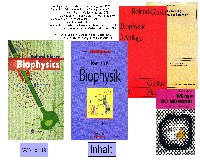|
What then was life? It was warmth, the warmth generated by a form-preserving instability, a fever of matter, which accompanied the process of ceaseless decay and repair of albumen molecules that were too impossibly complicated, too impossibly ingenious in structure. It was the existence of the actually impossible-to-exist, of a half-sweet, half-painfull balancing, or scarcely balancing, in this restricted and feverish process of decay and renewal, upon the point of existence. It was not matter and it was not spirit, but something between the two, a phenomenon conveyed by matter, like the rainbow on the waterfall, and like the flame.
(Thomas Mann, The Magic Mountain, (translated by H.T.Lowe-Porter, Penguin Books, 1985, p. 275-276) |
 |
Contents
1. Nature and Subject of Biophysics
2. Molecular Structure of Biological Systems
2.1 Intramolecular Bonds
2.1.1 Some Properties of Atomic Orbitals
2.1.2 Covalent Bonds, Molecular Orbitals
2.1.3 Ionic Bonds
2.1.4 Coordinative Bonds, Metallo-Organic Complexes
2.1.5 Hydrogen Bond
2.2 Molecular Excitation and Energy Transfer
2.2.1 Mechanisms of Photon-Induced Molecular Excitation
2.2.2 Mechanisms of Molecular Energy Transfer
2.2.3 Photosynthesis as Process of Energy Transfer and Energy Transformation
2.3 Thermal Molecular Movement, Order and Probability
2.3.1 Thermodynamic Probability and Entropy
2.3.2 Information and Entropy
2.3.3 Biological Structures: General Aspects
2.3.4 Distribution of Molecular Energy and Velocity at Equilibrium
2.3.5 Energy of Activation, Theory of Absolute Reaction Rate
2.3.6 Thermal Molecular Movement
2.4 Molecular and Ionic Interactions as the Basis for the Formation of Biological Structure
2.4.1 Some Foundations of Electrostatics
2.4.2 The Water Structure, Effects of Hydration
2.4.3 Ions in Aqueous Solutions, the Debye-Hückel Radius
2.4.4 Intermolecular Interactions
2.4.5 Structure Formation of Biomacromolecules
2.4.6 Ampholytes in Solution, the Acid-Base Equilibrium
2.5 Interfacial Phenomena and Membranes
2.5.1 Surface and Interfacial Tensions
2.5.2 Self Assembly and the Molecular Structure of Membranes
2.5.3 Mechanical Properties of Biological Membranes
2.5.4 Electrical Double Layers and Electrokinetic Phenomena
2.5.5 The Electrostatic Structure of the Membrane
3. Energetics and Dynamics of Biological Systems
3.1 Some Fundamental Concepts of Thermodynamics
3.1.1 Systems, Parameters, State Functions
3.1.2 Gibb's Fundamental Equation
3.1.3 Force and Motion
3.1.4 Entropy and Stability
3.1.5 The Thermodynamic Basis of Biochemical Reactions
3.2 The Aqueous and Ionic Equilibrium of the Living Cell
3.2.1 Osmotic Pressure
3.2.2 Electrochemical Equilibrium - The Nernst Equation
3.2.3 The Donnan Equilibrium
3.3 The Thermodynamic Analysis of Fluxes
3.3.1 Fluxes of Uncharged Substances
3.3.2 Fluxes of Electrolytes
3.3.3. The Diffusion Potential
3.4 The Nonequilibrium Distribution of Ions in Cells and Organelles
3.4.1 Ion Transport in Biological Membranes
3.4.2 The Network of Cellular Transporters. The Cell as an Accumulator of Electrochemical Energy
3.4.3 The Action Potential
3.4.4 Extracellular Biogenic Electric Fields and Currents
3. 5 Electric Fields in Cells and Organism
3.5.1. The Electric Structure of the Living Organism
3.5.2 Electric Fields in the Extracellular Space
3.5.3 Passive Electrical Properties of Tissue and Cell-suspensions
3.5.4 Single cells in external electric fields
3.5.5 Manipulation of Cells by Electric Fields
3.6 Mechanical Properties of Biological Materials
3.6.1 Some Basic Properties of Fluids
3.6.2 The Viscosity of Biological Fluids
3.6.3 Viscoelastic Properties of Biomaterials
3.6.4 The Biomechanics of the Human Body
3.7 Biomechanics of Fluid Behavior
3.7.1 Laminar and Turbulent Flows
3.7.2 Biomechanics of Blood Circulation
3.7.3 Swimming and Flying
4. Physical Factors of the Environment
4.1 Temperature
4.2. Pressure
4.3 Mechanical Oscillations
4.3.1 Vibration
4.3.2 Sound
4.3.3. The Biophysics of Hearing
4.3.4 Infrasound
4.3.5 Biophysics of Sonar Systems
4.3.6 The Effects of Ultrasound
4.4. Static, and Electromagnetic Fields
4.4.1.The Static Magnetic Field
4.4.2 The Electrostatic Field
4.4.3 Electromagnetic Fields in Human Environment
4.4.4. Biological Effects of Electromagnetic Fields
4.5 Ionizing Radiation
4.5.1 Nature, Properties and Dosimetry of Radiation
4.5.2 Primary Processes of Radiation Chemistry
4.5.3. Radiobiological Reactions
4.5.4 Some Aspects of Radiation Protection
4.5.5 Mathematical Models of Primary Radiobiological Effects
5. The Kinetics of Biological Systems
5.1 Some Foundations of Systems Theory
5.1.1 Problems and Approaches of System Analysis
5.1.2 General Features of System Behavior
5.1.3 Cybernetic Approaches to System Analysis
5.2 Systems of Metabolism and Transport
5.2.1 Introduction to Compartmental Analysis
5.2.2. Models of Biochemical Reactions
5.2.3 Pharmacokinetic Models
5.3 Model Approaches to Some Complex Biological Processes
5.3.1 Models of Propagation and Ecological Interactions
5.3.2 Models of Growth and Differentiation
5.3.3 Models of Evolution
5.3.4 Models of Neural Processes